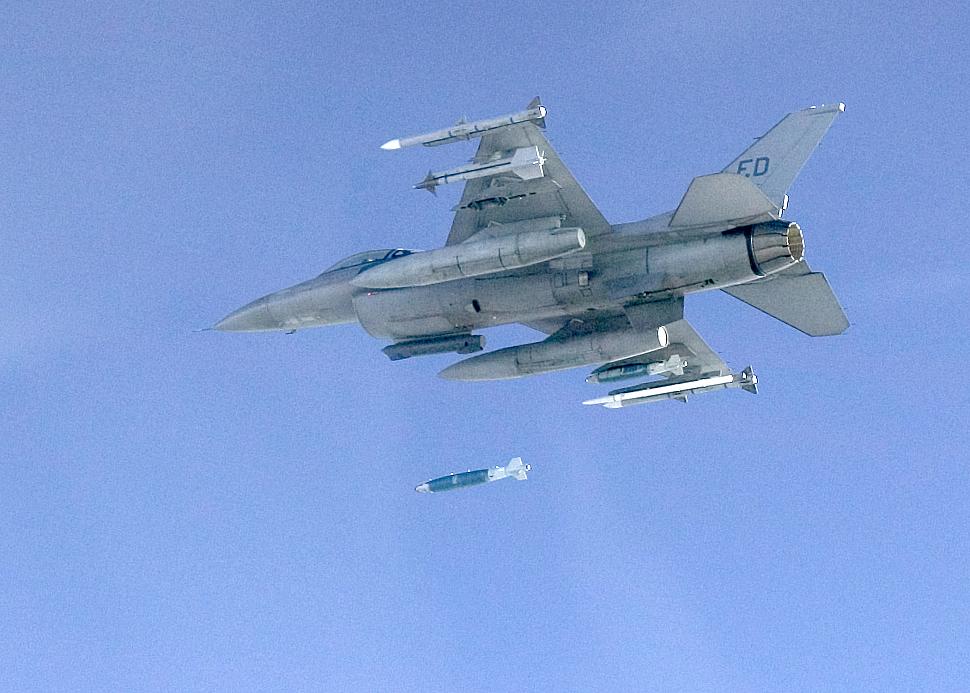Fighter Jet News
F-16 Fighting Falcon News
Test acceleration increases strike punch of F-16s
August 12, 2004 (by
1st. Lt. Brooke Davis) -
Experts at Edwards AFB accelerated testing to equip the F-16 Fighting Falcon, for the first time ever, with a 500 pound Joint Direct Attack Munition so overseas warfighters can use the new capability sooner.

Experts from the 416th Flight Test Squadron built-up to releasing three inert, guided JDAM weapons, known as JBU-38s, from a block 30 F-16 at China Lake Warfare Center Weapons Division Range in China Lake, Calif. They successfully completed developmental testing here.
"In 30 days, operational and developmental testing were completed, which is a huge success highlighting the abilities of experts in various technical fields that worked on the test acceleration,' said Doug Pawlik, 412th Test Wing F-16 project manager.
The GBU-38 decreases the potential for collateral damage on a target and increases the warfighter's ability to precisely hit specific targets, said Maj. Don Sheesley, 416th Flight Test Squadron project pilot.
He said it took "an enormous amount of coordination' between officials at the Air Force Seek Eagle Office at Eglin AFB, Fla.; Hill AFB, Utah; the Edwards and China Lake test ranges; and numerous contractors to certify the Block 30 F-16 capable of carrying the GBU-38.
F-16 Global Power Fighters Combined Test Force experts used a Block 30 F-16 from Edwards and the Air National Guard Air Force Reserve Test Center in Arizona to complete the six sorties here and at China Lake, Major Sheesley said.
"Block 30 F-16s are used throughout the Air Force, particularly by the Air National Guard,' he said. "The accelerated test sent the new weapons capability right to OT [operational testing] from DT [developmental testing], directly supporting a need to have the precision targeting capability the GBU-38 offers.'
The F-16 block number increases when a new production configuration is established. Block 30 F-16s, also known as F-16 C/Ds, are older airframes with specific engines, cockpit controls and display technology, Major Sheesley said.
In a combined effort, test experts put together elements needed for the accelerated testing, which included tail kits, bomb bodies, software, ground testing and data analysis, according to Mr. Pawlik.
"Test range members at both Edwards and China Lake pulled many overtime hours to process data collected from the six sorties,' said Mr. Pawlik. "Without this effort and dedication by the ranges and the CTF, the developmental testing would have taken much longer to pass on to operational testers.'
The captive-carry sorties, or sorties where the aircraft carried but didn't release the weapon, gathered system integration and performance data for CTF engineering officials to certify the Block 30 F-16 airframe to employ the GBU-38 weapons, said Major Sheesley.
Air Force Seek Eagle Office experts analyze data collected from sorties and certifies aircraft to carry new weapons.
AATC experts' operational testing at the Utah Test and Training Range, located near Hill AFB, recently wrapped up, and warfighters overseas will soon be able to use the precision-guided GBU-38 capability on F-16 Block 30s.

Maj. Don Sheesley, 416th Flight Test Squadron project pilot, releases for the first time ever a 500-pound Joint Direct Attack Munition. In support of real-world operations, testers from the Global Power Fighters Combined Test Force here performed accelerated testing to equip the F-16 with a 500-pound JDAM, or GBU-38, that was completed July 16. [Photo by Jim Shryne
]
"In 30 days, operational and developmental testing were completed, which is a huge success highlighting the abilities of experts in various technical fields that worked on the test acceleration,' said Doug Pawlik, 412th Test Wing F-16 project manager.
The GBU-38 decreases the potential for collateral damage on a target and increases the warfighter's ability to precisely hit specific targets, said Maj. Don Sheesley, 416th Flight Test Squadron project pilot.
He said it took "an enormous amount of coordination' between officials at the Air Force Seek Eagle Office at Eglin AFB, Fla.; Hill AFB, Utah; the Edwards and China Lake test ranges; and numerous contractors to certify the Block 30 F-16 capable of carrying the GBU-38.
F-16 Global Power Fighters Combined Test Force experts used a Block 30 F-16 from Edwards and the Air National Guard Air Force Reserve Test Center in Arizona to complete the six sorties here and at China Lake, Major Sheesley said.
"Block 30 F-16s are used throughout the Air Force, particularly by the Air National Guard,' he said. "The accelerated test sent the new weapons capability right to OT [operational testing] from DT [developmental testing], directly supporting a need to have the precision targeting capability the GBU-38 offers.'
The F-16 block number increases when a new production configuration is established. Block 30 F-16s, also known as F-16 C/Ds, are older airframes with specific engines, cockpit controls and display technology, Major Sheesley said.
In a combined effort, test experts put together elements needed for the accelerated testing, which included tail kits, bomb bodies, software, ground testing and data analysis, according to Mr. Pawlik.
"Test range members at both Edwards and China Lake pulled many overtime hours to process data collected from the six sorties,' said Mr. Pawlik. "Without this effort and dedication by the ranges and the CTF, the developmental testing would have taken much longer to pass on to operational testers.'
The captive-carry sorties, or sorties where the aircraft carried but didn't release the weapon, gathered system integration and performance data for CTF engineering officials to certify the Block 30 F-16 airframe to employ the GBU-38 weapons, said Major Sheesley.
Air Force Seek Eagle Office experts analyze data collected from sorties and certifies aircraft to carry new weapons.
AATC experts' operational testing at the Utah Test and Training Range, located near Hill AFB, recently wrapped up, and warfighters overseas will soon be able to use the precision-guided GBU-38 capability on F-16 Block 30s.
Courtesy of Air Force Flight Test Center Public Affair
Related articles:
Tags
Tags
